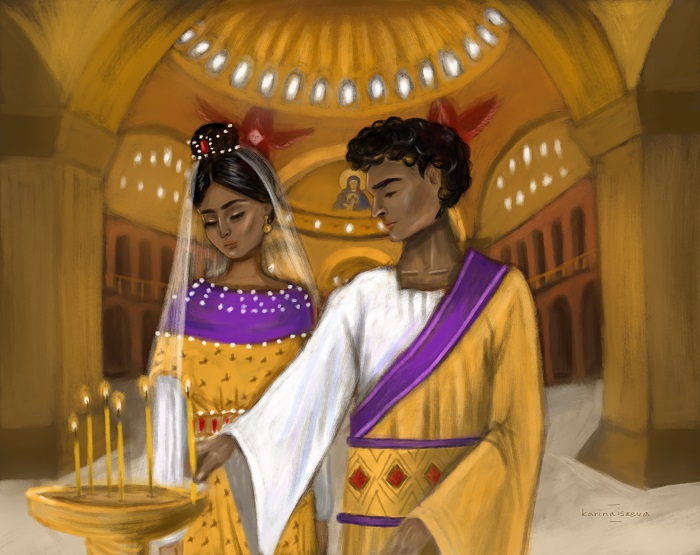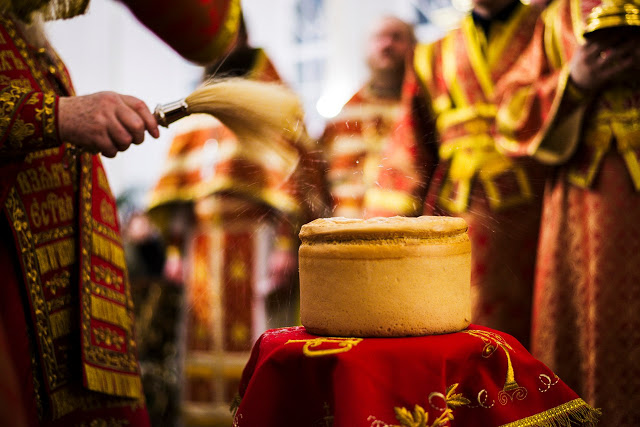
We know from the Church history that there hadn’t existed any special ritual of Matrimony until the 9th century. The Sacrament of Matrimony was performed during the Eucharist. The newly-weds would partake of the Holy Gifts, which served as the seal of marriage, in Tertullian’s words. That was why if for some reason the couple couldn’t partake of the Lord’s Chalice together, their marriage didn’t receive the blessing of the Church.
First references to a marriage ritual appear in the 4th century. Saint John Chrysostom explains in his homilies that crowns symbolize the victory of Christians over their passions. We may assume from a letter by St. Theodore the Studite that the ritual of Matrimony was short and was performed by a bishop or a presbyter during a Liturgy (St. Theodore the Studite, Letter 22: To Monk Symeon). Ancient euchologies of the same century contain the ritual of Matrimony, which was celebrated immediately after the Eucharist. How did the Matrimony get separated from the Liturgy, this common cause, and become a private Sacrament, which doesn’t involve the whole congregation?
The answer lies in Novella 89 of Emperor Leo VI the Wise († 912). Prior to that new law, marriage was registered directly by public administration, and marriage was governed by applicable Roman law. One could marry more than once and then get divorced, and it was allowed by Roman law. The Church did punish that person with a penance but his or her subsequent marriages were absolutely legal in the eyes of the state. Emperor Leo decided that from then on, marriage affairs were to be relegated to the Church, and that a marriage without a church blessing “would not be regarded as matrimony”. Instead, it was to be regarded as illegal concubinage. As the result of the reform, the Church was made responsible to the state for marriages and divorces, which was a new and unexpected challenge for Her. Following Leo’s novella, the line that separated civil marriage from church marriage began to blur. The Church was forced into blessing marriages She hadn’t allowed before. For instance, the same Emperor Leo VI forced the Patriarch to officiate his fourth (!) marriage with Zoe Karbonopsina.

The Church sometimes had to seek compromise with the government. However, the sacred nature of the Eucharist was too important to be compromised. It was due to their fear of compromising the greatest Sacrament of the Church that the Fathers decided to separate the Eucharist from the wedding ritual in the 10th century. Now the Church could stay on top of the new requirements while remaining true to Her ancient principles and norms. If a priest had to bless a second or even a third marriage, he would perform a special wedding ritual, which excluded the crowns and contained penitential chants instead of laudatory ones. In the place of joint participation in the communion of the Body and Blood of Christ, the new couple received a cup of wine blessed by the priest. Those who married a second time were not allowed to partake of the Eucharist for several years, and that allowed the Church to maintain penitential discipline. At the same time, it was clear to the Fathers of the Church that Christian marriage is intrinsically bound with the Church, and therefore with the Eucharist, which was why the faithful who were marrying for the first time, partook of presanctified Holy Gifts during the Sacrament of Matrimony, thus becoming united to Christ and one another in this great Sacrament of Communion. The practice remained unchanged until the 15th century. The contemporary ritual preserves numerous traces of its ancient Eucharistic roots. Thus, in the beginning of the Sacrament of Matrimony, the priest exclaims Blessed is the Kingdom… – the exclamation which opens up the Divine Liturgy. Before drinking the common cup of wine, the choir sings Our Father, which is another reference to the Eucharist. According to the usual practice, the couple should confess and take communion of the Holy Sacraments before or after the wedding so as to ‘seal’ their marriage with the Lord’s Supper.
The Sacrament of Matrimony is one of the seven Sacraments of the Church, and as such, it depends on the Sacrament of Sacraments, that is, the Holy Eucharist. Eucharistically speaking, the husband and the wife are not only one body with one another but also members of the Body of Christ and the whole Church, effectively becoming a home church themselves. In any case, being a home church where the husband represents Christ and the wife represents the Bride of Christ is an enormous responsibility. Conscious participation in the life of the Church and spiritual growth are the only ways to achieve the exalted ideal of a Christian marriage.



